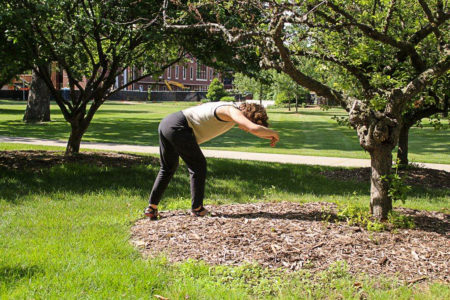
Mentored Advanced Projects (MAPs) in the arts at Grinnell College provide students and faculty alike with the unique, institutionally-supported opportunity to fully commit to and explore the creative process.
In MAPs, students work closely with professors, create their own work and often get to see their pieces performed or published both in Grinnell and in a larger context. Grinnell facilitates this process through subsidizing materials, housing and even travel, demonstrating the College’s institutional commitment to fostering student research across all disciplines.
Yet, when the MAP process comes to an end, many professors in the arts face filling out an evaluation form for their students’ work which largely presumes the form of that work to be a research paper.
Professor Ralph Savarese, English, led a group poetry MAP this summer that produced a body of poetic work which participants will submit to poetry journals and present at a public reading.
“The MAP program enthusiastically welcomes projects in the creative arts. I couldn’t be happier with the support that my MAP students have received. My gripe is with the MAP evaluation form, which caters to traditional scholarly endeavors. It doesn’t allow any kind of meaningful assessment of creative writing,” Professor Savarese wrote in an email to the S&B.
The criteria on said evaluation form works well with an academic research paper, but mental gymnastics are required to apply the standards to a creative work, such as a poem.
The evaluation asks professors to rate students on their proficiency in areas such as “Critical Reading,” “Argumentation,” “Evidence” and “Factual and Theoretical Context.” In this list of 12 categories for assessing students’ research proficiency, “Creativity” is allotted a single category, and is last on the list.
While this logistical inconsistency does not represent a lack of support for creative research at Grinnell, the mismatch points to a larger conversation about how scholarship in the humanities, specifically in the creative arts, often takes less traditional forms than that of other academic disciplines, both in practice and in product.
Professor John Rommereim, music, has directed students in choral MAPs for 20 years. The MAPs he directs typically take three forms: music composition, choral conducting and solo singer recitals. He stated that it is important for his composition students to have study and analysis in order to expand their approaches to writing music. He frequently has students journal their responses to musical works they encounter in their research.
Rommereim’s students submit their musical work to competitions, personally conduct the Grinnell Singers choir and have the opportunity to record their compositions with professional musicians.
The questions on the evaluation are incompatible with such projects as these where, as Rommereim asserted, “the emphasis isn’t on creating a piece of written word, [but] rather written music,” or even non-notated music that exists only electronically.
Associate Dean of the College Maria Tapias acknowledges that this incompatibility is a problem. “Obviously different fields will have different assessments,” she said. “We recognize that the current assessment form might be more compatible with some fields than others.”
Tapias stated that the Dean’s office had previously gathered a faculty group to work on a better assessment, and that the College sent members of the faculty to a workshop last year to collaborate with other institutions regarding these concerns. Due to conflicts in scheduling, however, the form remains a lingering question for the institution.
“How do we create a research assessment form that acknowledges the creative process? Tapias said. “How do you quantify that?”
In a subsequent email correspondence with the S&B, Tapias added, “The creative process cannot really be quantified and hence finding a tool that ‘measures’ creativity will always be a challenge.”
As Tapias is in the process of transitioning out of the role of Associate Dean, she asserted that her successor Mark Levandoski will continue to work on this issue.
Despite the unsuited medium of the MAP evaluation form, arts professors assert the scholarly rigor of artistic practice through their mentorship of students.
“In my classes, now, what I’m trying to do is find ways to make it continually more explicit that our creative process and practice is a research practice that has a different shape to it,” said Professor Celeste Miller, theatre and dance. “How can my students work with me as partners so that, as partners, we can continue to clearly articulate that?”
Part of that articulation consists of students taking ownership over their own research practice.
“I think I really didn’t know what [the dance research process] meant in the beginning,” said Naomi Worob ’19, who completed a dance MAP this summer with Professor Miller. “I felt like I didn’t know how to explain myself and I also felt that people were coming at [dance research] from a certain perspective of not respecting dance as much as other academic subject areas.”
Worob and her research partner Obuchi Adikema ’21 researched embodied experiences in the environment.
“I was much better at the end of the summer about articulating what I was doing and knowing for myself why [my research] was important and how to share that,” Worob said.
Empowerment of student research bolsters arts MAPs at Grinnell. “It’s a process of self-discovery and self-realization,” Rommereim said. “… an expansion of what you’re capable of.”





























































